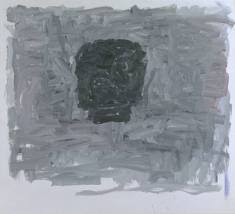After a lazy afternoon overlooking the Thames, discussing everything from Michael
Haneke’s films through the dire state of the academic institution in Britain,
to life and love, my dear friend James and I ventured inside the Tate Modern to spend
some time together with six of my favorite paintings: Cage I-VI. I have seen these six paintings many times, and I have
written about them more than once. Similarly, James and I had seen them together on the occasion of the Panorama retrospective in October 2011. We went back, because I wanted to be with them, experience them
together once again with him. I wanted to see what came out of the three-way conversation,
a conversation between James, myself and Cage
I-VI. And James was keen to see them again having lived with a poster reproduction of Cage V for some months: how would the colours compare?
 |
| Mark Rothko, The Seagram Murals, 1958 |
The first thing we discussed was the exhibition of the
Richter paintings and Rothko’s The Seagram
Murals. While other works in the current hanging of the permanent
collection are thematized: apparently to reflect abstract connections such as
“Poetry and Dream,” “Energy and Process” and the like, Cage I-VI and The Seagram
Murals have their own rooms. I couldn’t help comparing the display of the
two series. The dimmed lighting, the single entrance, the placement of a bench in the middle of the room, all of it creates, or rather, imposes a temple-like environment for Rothko's paintings. Richter’s Cage paintings however, are
filled with light coming in from above, from the entrances on either side of
the room, and because there is no seat in the middle, our own motion around the
room. The openness and volume of the canvases asks us to look upwards
and outwards as we move to see them from different perspectives, together, singularly, up close and at a distance. In distinction
from the demand of The Seagram Murals that
we look inwards and remain silent and static, Cage I-VI fill us with energy and motion.
 |
| Philip Guston, Head I, 1965 |
As we arrived at Level 3, "Transformed Visions," James asked me, “so what is grey”? A question I should be able to answer by now. But all I could do was agree with his reflection that "I have never really known what grey is, and I have never known how to spell it." In Room 2, we stopped before Philip Guston's Head I, 1965. The plate accompanying the painting quotes Guston: “I use white
pigment and black pigment. The white pigment is used to erase the black I don’t
want and so becomes grey. Working with these restricted means as I do now,
other things open up which are unpredictable, such as atmosphere, light,
illusion — elements which do seem relevant to the image but have nothing to do
with colour.” What’s so striking about all of the grey paintings in this
room, and later with the Richters, is that grey is about so much more than
Guston claims. Similarly, it is about so much more than we would expect. For Guston
in Head I, grey is about light and
energy, it's about illusion and reality, especially as it gives depth to the
head in the title. Grey is also about uncertainty and whether the grey is in
relief or perhaps it is receding, leaving the black in the foreground? The
freedom of the grey brushstrokes — that are, it is worth mentioning, mixed in
with red and blue — warm, generous, and they create a painted surface in flux, glowing.
With all these contradictions left hanging through the
presence of grey on the canvas, James had of course, announced the central problem addressed by
my forthcoming book, “The Truth is Always
Grey” when he said, "I have never really known what grey is, and I have never known
how to spell it". This, of course, is my attraction to grey.
So what is grey doing in Cage
I-VI? We discussed together that grey is everywhere and nowhere in these
paintings. James noticed that grey was impossible to comprehend. While other
colours, yellow, red, blue, green, are quantifiable, or rather, can be
qualified, seen, understood in their verticality, in their horizontality, in
their definitiveness. Grey is more difficult. Yellow is yellow, red is red,
blue is blue, but grey is a whole spectrum of ever shifting tones,
temperatures, densities. Is it the background or the foreground? Is it
horizontal or vertical? Does it erase, or is it erased?
And then as we contemplated these questions, we recognized
that the opposite is also true. The vivacity of this contradiction is what
makes Richter great and grey indispensible to his greatness. Because grey is
the one thing, the one colour that remains the same. While blue becomes yellow
which takes over from green, grey, at least within each painting is consistent.
It exists. Up close, each of the six Cage
paintings changes, shifts from what it was at a distance. Red becomes
magenta, it becomes orange, and then in places, it is pink and even purple. Red
is anything but stable in these paintings.
It is this ambiguity, this uncertainty and continuing
contradiction that makes grey the most exciting of all colours for Richter.
Grey is lush, it is playful, filled with light, with air, with possibility and
infinity. Grey on the canvases of Cage
I-VI is what opens them upwards and outwards, lifting the viewer to a
belief in the possibility of painting.





No comments:
Post a Comment